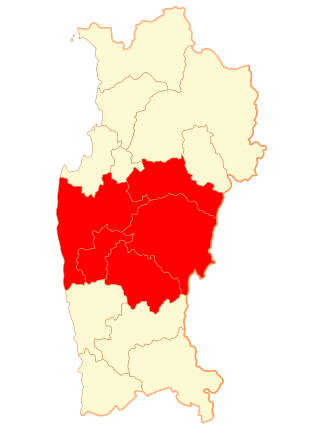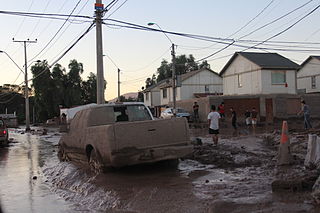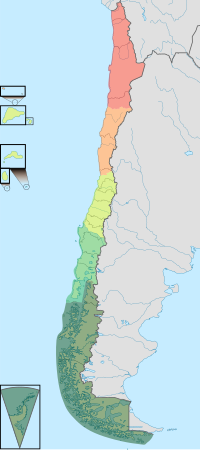
The Antofagasta Region is one of Chile's sixteen first-order administrative divisions. The second-largest region of Chile in area, it comprises three provinces, Antofagasta, El Loa and Tocopilla. It is bordered to the north by Tarapacá, by Atacama to the south, and to the east by Bolivia and Argentina. The region's capital is the port city of Antofagasta; another one of its important cities is Calama. The region's main economic activity is copper mining in its giant inland porphyry copper systems.

The Atacama Region is one of Chile's 16 first order administrative divisions. It comprises three provinces: Chañaral, Copiapó and Huasco. It is bordered to the north by Antofagasta, to the south by Coquimbo, to east with Provinces of Catamarca, La Rioja and San Juan of Argentina, and to the west by the Pacific Ocean. The regional capital Copiapó is located at 806 km (501 mi) north of the country's capital of Santiago. The region occupies the southern portion of the Atacama Desert, the rest of the desert is mainly distributed among the other regions of Norte Grande.

The Coquimbo Region is one of Chile's 16 regions. It is bordered by Atacama to the north, Valparaíso to the south, Argentina to the east, and the Pacific Ocean to the west. It is approximately 400 kilometres (250 mi) north of the national capital, Santiago.

Chile has a long history in the production of wine, with roots dating back to the 16th century when the Spanish conquistadors introduced Vitis vinifera vines to the region. In the mid-19th century, French wine varieties such as Cabernet Sauvignon, Merlot, Carmenère, and Franc were introduced. During the early 1980s, the Chilean wine industry underwent a renaissance with the introduction of stainless steel fermentation tanks and the use of oak barrels for aging. This led to a rapid growth in exports as quality wine production increased. The number of wineries in Chile rose from 12 in 1995 to over 70 in 2005.

Vicuña is a Chilean commune and city in Elqui Province, Coquimbo Region, founded during the government of Bernardo O'Higgins to secure sovereignty over the Elqui Valley. Poet Gabriela Mistral was born there in 1889. It shares borders to the west with the communes of La Higuera, La Serena and Andacollo, to the east with Argentina and to the south with Paihuano and Rio Hurtado. The commune is administered by the municipality of Vicuña, which is the principal city of the Valle de Elqui.

The Elqui River starts in the west Andes and flows into the Pacific Ocean near the Chilean city of La Serena. It is a wine and pisco producing area. Vicuña, the main town of the middle valley, was the home of Nobel Laureate poet Gabriela Mistral.

The Chilean Coastal Range is a mountain range that runs from north to south along the Pacific coast of South America parallel to the Andean Mountains, extending from Morro de Arica in the north to Taitao Peninsula, where it ends at the Chile Triple Junction, in the south. The range has a strong influence on the climate of Chile since it produces a rain shadow to the east. Because of this the vegetation growing on the seaward slopes is much more exuberant than in the interior. Compared to the coastal lowlands and the Intermediate Depression, it is sparsely populated with land use varying from protected areas to grazing and silviculture. The range is present in all Chilean regions, except for Coquimbo Region and Magallanes Region.

The Norte Grande is one of the five natural regions into which CORFO divided continental Chile in 1950. It borders Peru to the north, the Pacific Ocean to the west, the Altiplano, Bolivia and Argentina to the east, and the Copiapó River to the south, beyond which lies the Norte Chico natural region.

Salamanca is a Chilean city and commune in Choapa Province, Coquimbo Region. It is located 30 km (19 mi) east of Illapel, the province's administrative center, and 316 km (196 mi) north of Santiago, Chile. It is normally accessed from Los Vilos, which lies next to the Panamerican Highway, and connects the city to the rest of the country.

Limarí Province is one of three provinces of the Chilean region of Coquimbo Region (IV). Its capital is the city of Ovalle

The native flora of Chile is characterized by a higher degree of endemism and relatively fewer species compared to the flora of other countries of South America. A classification of this flora necessitates its division into at least three general zones: the desert provinces of the north, Central Chile, and the humid regions of the south.

Agriculture in Chile encompasses a wide range of different activities due to its particular geography, climate, geology and human factors. Historically agriculture is one of the bases of Chile's economy, now agriculture and allied sectors—like forestry, logging and fishing—account only for 4.9% of the GDP as of 2007 and employed 13.6% of the country's labor force. Some major agricultural products of Chile include grapes, apples, onions, wheat, corn, oats, peaches, garlic, asparagus, beans, beef, poultry, wool, fish and timber. Due to its geographical isolation and strict customs policies, Chile is free from diseases such as Mad Cow, fruit fly and Phylloxera, this plus being located in the southern hemisphere and its wide range of agriculture conditions are considered Chile's main comparative advantages. However, the mountainous landscape of Chile limits the extent and intensity of agriculture so that arable land corresponds only to 2.62% of the total territory.

Since the mid-1990s, tourism in Chile has become one of the main sources of income for the country, especially in its most extreme areas. In 2005, this sector grew by 13.6%, generating more than US$500 million, equivalent to 1.33% of the national GDP.

The Transverse Valleys are a group of transverse valleys in the semi-arid northern Chile. They run from east to west, being among the most prominent geographical features in the regions they cross. They are located in the Chilean regions of Valparaíso, Coquimbo, and Atacama. They share some characteristics, such as reaching the Pacific Ocean without passing through an Intermediate Depression, being rather deep and dissecting the landscape, concentrating most agriculture and population in the areas through which they pass, and being intensively cultivated. They are one of the defining elements of the Chilean natural region of Norte Chico. The area of the Transverse Valleys spans roughly 600 km from north to south.
Eupithecia sibylla is a moth in the family Geometridae. It is found in the regions of Los Gatos, Antofagasta, Atacama, Coquimbo, Valparaiso, Santiago, O'Higgins, Maule and Biobio in Chile. The habitat consists of the Northern Desert, Northern Coast, Intermediate Desert, Coquimban Desert, Central Andean Cordillera, Central Valley, Valdivian Forest and the Northern Valdivian Forest biotic provinces.
Through its history, Chile was regularly affected by droughts. In the more arid parts of Chile droughts are produced when there are low amounts of snow accumulation in the Andes. Chilean coastal basins without snow accumulation are particularly vulnerable to drought.
The Elqui Valley is a wine region centered on Elqui River in northern Chile. The Elqui Valley Denomination of Origin (DO) is defined by the Chilean appellation system, the legally defined and protected geographical indication used to identify where the grapes for a wine were grown. The region lies 400 km (250 mi) north of Santiago, at the southern end of the Atacama Desert in the Coquimbo region. It is known for producing table grapes and other fruits, as well as pisco brandy, Chile’s most popular liquor. It is considered the most commercially viable wine-producing region of northern Chile.

Inca rule in Chile lasted from the 1470s to the 1530s when the Inca Empire was absorbed by Spain. The main settlements of the Inca Empire in Chile lay along the Aconcagua, Mapocho and Maipo rivers. Quillota in Aconcagua Valley was likely the Incas' foremost settlement. The bulk of the people conquered by the Incas in Central Chile were Diaguitas and part of the Promaucae. Incas appear to have distinguished between a "province of Chile" and a "province of Copayapo" neighboring it to the north. In Aconcagua Valley the Incas settled people from the areas of Arequipa and possibly also the Lake Titicaca.

The 2015 Northern Chile floods were a series of mudflows that affected much of northern Chile, product of flash floods from different rivers due to unseasonal heavy rains in the area, causing severe damage in several towns of the Antofagasta, Atacama and Coquimbo regions. Flooding in Chile and Peru resulted from an unusual cold front which moved across the Andes, bringing heavy rainfall to the region.

Coquimbo Formation is a Miocene to Middle Pleistocene sedimentary formation located in Coquimbo Region in Norte Chico, Chile. The lowermost unit belongs to the lower Miocene, with the third-deepest unit dated at 11.9 ± 1.0 Ma. The uppermost unit of the formation is estimated at 1.2 Ma. In the area of Tongoy, the Coquimbo Formation was deposited in an ancient bay that was formed in a graben or half-graben, with a normal fault dipping east. Sea level changes during the Holocene have caused erosion to cut several marine terraces into the formation.





















